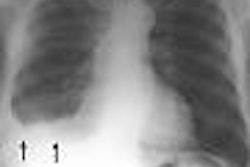The proposed 2005 PET reimbursement rates for the Hospital Outpatient Prospective Payment System (HOPPS) could knock the wind out of PET's sails just as the modality is getting up to speed.
The Centers for Medicare and Medicaid Services (CMS) states in its proposed rule: "We note that a number of PET scans currently are classified into New Technology APC (Ambulatory Patient Code) 1516. We recognize that PET is an important technology in many instances and want to ensure that the technology remains available to Medicare beneficiaries when medically necessary. We believe that we have sufficient data to assign PET scans to a clinically appropriate APC.
"We have been told, however, that if the effect of doing so is to reduce payment for the procedure, it may hinder access to this technology," the proposal continues. "Therefore, we are considering three options as the proposed payment for these procedures in CY (calendar year) 2005, based on our review of the 2003 claims data for the PET procedures, and we specifically invite comments on each of these options" (Federal Register, August 16, 2004, Vol. 69:157).
The agency has invited comment from PET practitioners on three alternative payment levels:
- Continue in CY 2005 the current assignment of the scans to the New Technology APC 1516 prior to assigning to a clinical APC. This would leave the HOPPS reimbursement in 2005 at the 2004 level of $1,450.
- Assign the PET scans to a clinically appropriate APC (0420) priced according to the median cost of the scans based on CY 2003 Medicare claims data. The proposed APC payment for 2005 would be $898.64, a decrease of 38%.
- Transition assignment to a clinical APC in CY 2006 by setting payment for CY 2005 on the basis of a 50-50 blend of the median cost from CY 2003 and the CY 2004 New Technology APC. The APC 1513 would be assigned for a blended transition payment. The proposed APC payment for 2005 would be $1,150, a decrease of 20%.
"We've always had concerns about the Medicare database," said Dr. R. Edward Coleman, president-elect of the Los Angeles-based Academy of Molecular Imaging (AMI).
"When we've looked at the individual numbers in the past, part of the data that CMS gets shows that the cost of a PET scan is under $100," added Coleman, who is also professor of radiology, director of the division of nuclear medicine, and vice chair of the department of radiology at Duke University Medical Center in Durham, NC.
"Some hospitals have submitted data that their cost of doing a PET scan is less than $100, which obviously is incorrect. So there are problems, obvious problems, in the data that Medicare is receiving from hospitals. I don't deny that that's the data CMS gets, but it's obviously incorrect data," he said.
The AMI has conducted its own analysis on the cost of performing PET scans, and the data shows with two patients per day, including the radiopharmaceutical 18-FDG, the cost of performing a scan is about $1,800.
"Unfortunately, there still are several centers out there ... doing a low volume of studies," Coleman said. "If the reimbursement is cut back at this point in time, we're going to see decreased access for patients getting PET scans, and that's a concern to AMI and the PET community."
The reimbursement cuts are particularly worrying to facilities that have purchased PET scanners in the past few years or are investigating adding PET services. Adding new technology to a practice is directly related to the ability to pay for it. The return on investment for a modality is determined by calculating its acquisition price and the cost of annual service against its throughput and reimbursement. A 20% to 40% reduction of either throughput or reimbursement severely impacts a financial pro forma for PET services.
"As a radiologist, this is one of the more time-consuming procedures to analyze, because you have to correlate the findings with exams from other modalities," said Dr. Harry Agress Jr., director of nuclear medicine and the PET center at Hackensack University Medical Center in New Jersey. "In view of how powerful PET scanning is, especially with CT, it would be unfortunate to see utilization decrease because reimbursement wasn't there."
For a PET scanner currently in place, the proposed reimbursement rates will greatly extend the time required to reach a breakeven point on the investment. For institutions considering a PET purchase, reimbursement changes will cause customers to redo the financial estimates of revenues PET would generate. If the returns aren't there, a facility could lose its financing for the modality or simply decide not to buy a system.
Reimbursement interdependence
Hospitals may not be the only ones affected by the proposed 2005 HOPPS payment rates. Independent diagnostic testing facilities (IDTFs) could see a move to aggressively recalculate payments in the private payor marketplace as well.
"We all have to be very concerned with the HOPPS rate because of that fallout," said Ruth Tesar, executive director of the Northern California PET Imaging Center in Sacramento, CA.
"I think the most important thing is to provide cost data, and when you meet with the payors, be able to justify the cost of your procedures," she said. "We may not be able to win all the time on the Medicare side, but as long as we have good data for the private payors that's an avenue where we can have some strength in making our rate argument."
"I think the immediate impact for an IDTF will be minimal," said Henry Soch, business director for Bridgeport, CT-based Advanced Radiology Consultants. "It is, however, a downstream concern if the reimbursement cuts go into effect, because ultimately we'll see it, too."
Radiopharmaceuticals and comments
The rates paid for the radiopharmaceuticals used for PET imaging, 18-FDG, Rb-82, and 13 N-ammonia, are also set for steep decreases in reimbursement. The proposed 2005 APC payment for FDG is $220.50, a more than 30% decline from 2004 APC rates of $324.48 per dose.
Rubidium and ammonia, used for PET perfusion imaging, are set to take a hit as well. The CMS is proposing 2005 reimbursement for both radiopharmaceuticals at $111.91 per dose, also a more than 30% decrease from 2004 APC rates of $162.63.
In addition, the proposed rule sets forth a reduction in the payment rate for myocardial perfusion PET scans using either radiopharmaceutical from the current payment rate of $772.08 down to $690.61 for 2005.
The proposed reimbursement changes are up for public comment until October 8 at 5 p.m. EDT, with a final decision to be made the first week of November. Comments to the proposed HOPPS PET rates must reference file code CMS-1427-P and can be made online on the CMS Web site.
"The AMI is supplying data to Medicare to show what the costs of PET scans are," Coleman said." We're also letting CMS know that if it does decrease the reimbursement amount it will decrease access to PET for patients that would benefit from these scans."
By Jonathan S. Batchelor
AuntMinnie.com staff writer
September 24, 2004
Related Reading
CMS to cover PET for Alzheimer's, September 17, 2004
Medicare set to raise outpatient rates, August 10, 2004
Medicare to raise payments to hospitals, August 3, 2004
CMS to reimburse PET for Alzheimer's, June 16, 2004
CMS expands outpatient reimbursement, April 6, 2004
Copyright © 2004 AuntMinnie.com



















